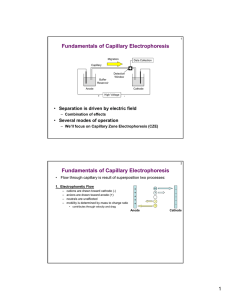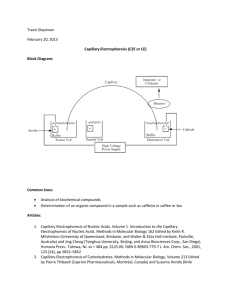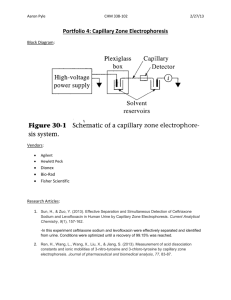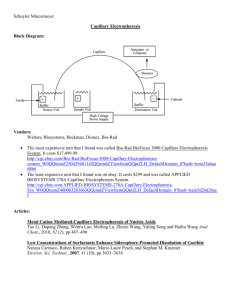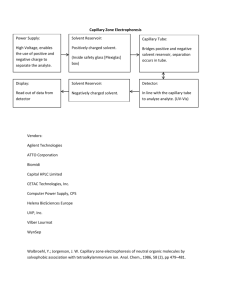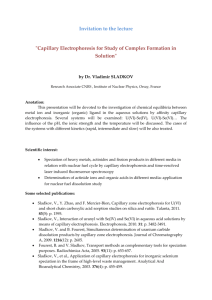Fundamentals of Capillary Electrophoresis • Separation is driven by electric field
advertisement
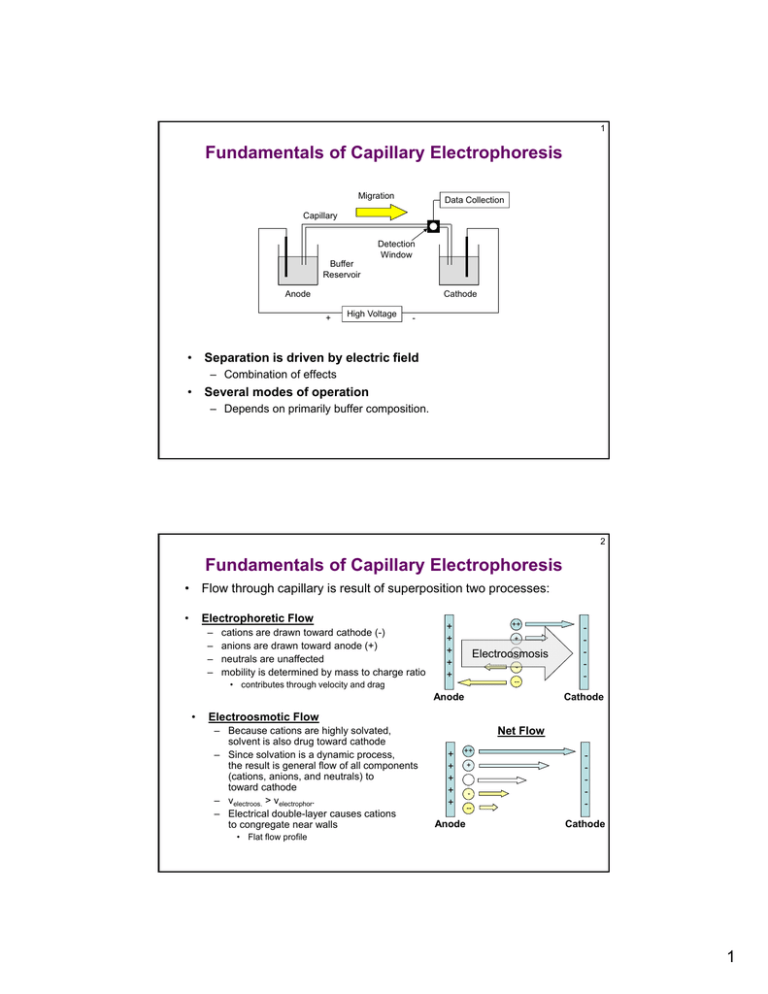
1 Fundamentals of Capillary Electrophoresis Migration Data Collection Capillary Detection Window Buffer Reservoir Anode Cathode + High Voltage - • Separation is driven by electric field – Combination of effects • Several modes of operation – Depends on primarily buffer composition. 2 Fundamentals of Capillary Electrophoresis • Flow through capillary is result of superposition two processes: • Electrophoretic Flow – – – – cations are drawn toward cathode (-) anions are drawn toward anode (+) neutrals are unaffected mobility is determined by mass to charge ratio ++ + + + + + + Electroosmosis -- • contributes through velocity and drag Anode • Cathode Electroosmotic Flow – Because cations are highly solvated, solvent is also drug toward cathode – Since solvation is a dynamic process, the result is general flow of all components (cations, anions, and neutrals) to toward cathode – velectroos. > velectrophor. – Electrical double-layer causes cations to congregate near walls Net Flow + + + + + ++ Anode + -- Cathode • Flat flow profile 1 3 Separation Efficiency in CE • Migration velocity: Depends on voltage and mobility v = (e + eo)E = (e + eo)V/L • Electrophoretic mobility may be positive (cations), zero (neutrals), or negative (anions). • Electroosmotic mobility is generally positive – Everything is being drawn to the cathode – Can be reversed by altering surface chemistry of the capillary • add cationic surfactant – Can be minimized by “neutralizing” the surface of the capillary • convert charged silanol groups to neutrals (like Si(CH3)3Cl) • Plate Height: N e eo V 2D – Independent of capillary length – High potential is better…ideally • fast separations • can lead to heating in capillary • accelerates diffusion increased broadening (not terrible) 4 Basic CE Instrument Components • Capillary: ~50-75 m i.d., tens of cm long – Care and feeding of capillaries is critical • High voltage power supply: kV potentials – Velocity voltage • Buffer – Need conductive solution • Potential challenges – Particulates – Poor conductivity – heating • Injection: Small capillaries require small injection volumes (nL to pL) – Electrokinetic Injection • non-uniform sampling due to mobility – Pressure Injection • uniform sampling 2 5 Basic CE Instrument Components • Detection: Similar to LC, but smaller sample so sensitivity is an issue. – Mobility also plays a role in peakshape since materials elute at different rates (different than LC) – Indirect detection is becoming more common 6 Electrophoresis vs. Electrochromatography • In CE there are still plenty of materials that are difficult to separate – Try to improve separation by modifying buffer composition or separation voltage • Zone Electrophoresis (CZE): single composition buffer, “classic” CE • Isotachhophoresis: two buffer compositions. Analytes distribute themselves between the extremes • Isoelectric Focusing: Buffer composition changes throughout capillary. Amphiprotic materials migrate toward their isoelectric point (pI). – At pI, amphiprotic material is “uncharged” 3 7 Electrophoresis vs. Electrochromatography • Electrochromatography: Hybrid technique – – • How to introduce second phase? – – • Two-phase separation driven by electroosmotic flow Separation is a result of partitioning of analytes between the two phases (chromatography!) Packed capillaries -fairly uncommon, tough to prepare Pseudo-stationary phase - component present in buffer that can allow partitioning of analyte • easier to do, much more flexible Micellar Electrokinetic Chromatography (MECC) – – Surfactant is added to buffer (SDS, etc) If surfactant concentration is appropriate, micelles form – – – • Exceed CMC Nonpolar interior of micelle acts as second phase • analytes partition into the phase on the basis of their distribution coefficients (K) • Micelles themselves have electrophoretic and electroosmotic mobility (negatively charged) More efficient than HPLC (more plates) Easy to change micellar phase! Chiral separations: chiral pseudo-stationary phase 8 MS Detection for CE • CE-MS – CE is probably best suited for coupling to MS • low volume flow rates – ESI is most common • “End” of the capillary is metalized • Allows application of potential for both separation and ionization – E(injection)>E(ionization)>ground 4
